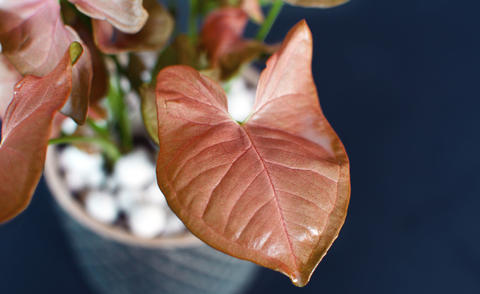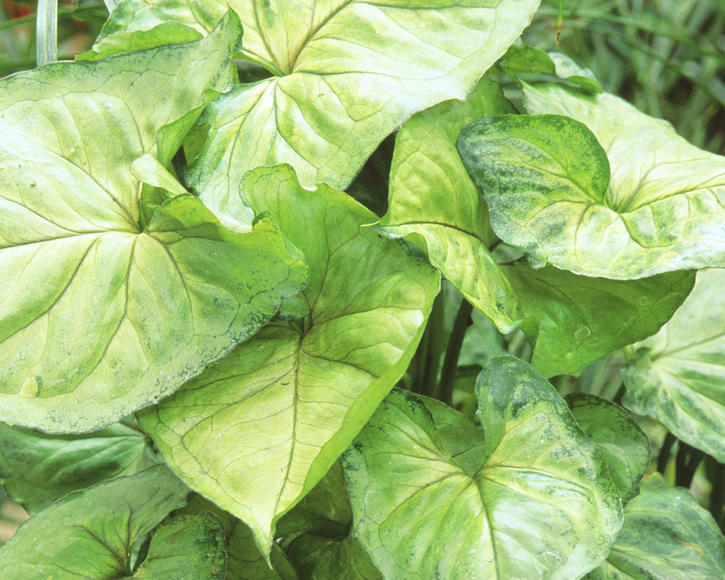Arrowhead plant
The arrowhead plant is known as a fast climbing plant, although it has also proven itself in hanging baskets. There are many beautiful varieties with colorful leaves.
Factsheet
- Growth type
-
- Climber
- Growth height (from)
- from 150 cm to 200 cm
- Growth characteristics
-
- hanging
- bushy
- Flower color
-
- green
- white
- Flower shape
-
- Spike
- Leaf color
-
- green
- red
- multicolored
- page format
-
- carved
- arrow-shaped
- Light
-
- scattered light to semi-shade
- Soil type
-
- sandy to loamy
- Soil Moisture
-
- moderately dry to moderately humid
- ph value
-
- weakly alkaline to neutral
- Lime compatibility
-
- lime-tolerant to sensitive to lime
- Nutrient requirements
-
- moderately nutritious
- Humus
-
- rich in humus
- Decorative or utility value
-
- Leaf ornaments
- Winter Hardness
-
- frost-sensitive
- Use
-
- Single position
- Interior greening
- Climbing aids
- Planters
- Warm House
- Garden style
-
- Pot garden
The arrowhead plant (Syngonium podophyllum) is one of around 35 to 41 species from the Syngonium genus. This in turn is a member of the Araceae family. The family is famous for its houseplants. Apart from arrowhead, it includes major players such as devil’s ivy (Epipremnum), Philodendron, dumb cane (Dieffenbachia), peace lily (Spathiphyllum) and Zantedeschia (calla). Syngonium podophyllum is native to Mexico, Guatemala, El Salvador, and Costa Rica.
The arrowhead plant climbs, hangs, or creeps - depending on where and how you position it in the room. It drapes its up to 6.56 foot long shoots elegantly over the edge of a hanging basket, adds horizontal greenery to window ledges, and bravely climbs upwards, if it is provided with a climbing aid. Overtime, the initially thin shoots become stronger and develop pronounced leaf nodes. There are attractive varieties of Syngonium podophyllum that are conspicuous due to their different colored leaves. The arrowhead plant is slightly poisonous. As with all Araceae, it contains calcium oxalate and oxalic acid.
The age of an arrowhead plant is reflected in the appearance of its shiny-leathery leaves. As its leaf shape changes over the years. In young devil’s ivy plants the lamina are arrow-shaped. Later, the leaves are deeply notched. The margin divides here five, seven, nine, or even eleven times. The leaves have a crenate stem, which is generally equally as long as the lamina.

If you discover a flower on your arrowhead plant, you can count yourself lucky. Because it only flowers if it is given the best all-round care. The rather inconspicuous flowers in the shape of a spike are encased by a green-white spathaceous bract.
Treat your arrowhead plant to a bright place with diffused light. This applies in particular to the varieties with colorful leaves. The more white the leaves have, the more light the green plant needs. However, direct sunlight is undesirable, particularly around the midday point. In summer, Syngonium podophyllum is also happy in a semi-shady place in the fresh air. During the darker times of year it is recommended to provide the arrowhead plant with daily light with the help of a plant light. Because it can only stay healthy through the winter with the proper light values.
A normal, high-quality houseplant soil ensures the well-being of Syngonium podophyllum.
The arrowhead plant is idiosyncratic where water supply is concerned. It tolerates neither waterlogging nor a dry ball for days on end. Instead, it likes to be continuously watered in moderate amounts. It also prefers stagnant, calcium-deficient, room temperature water. You should stop watering as soon as the water runs out of the drainage holes. It’s also good to pour excess water out of the planter after a few minutes. Then wait until the soil in the pot is dry before watering again. As the arrowhead plant is naturally used to high humidity, it is grateful if its shoots and leaves are regularly sprayed. It is very content in a bathroom climate.

Syngonium podophyllum is the perfect houseplant for those who are prone to forgetting to fertilize their plants. Because it prefers to be on a diet. It’s adequate to treat it to some liquid plant fertilizer every four to six weeks during the brighter months. The arrowhead plant should only be fertilized once between November and March.
Young arrowhead plants grow vigorously. When you see that its roots have conquered the pot and the arrowhead plant looks unhappy, then it’s time to move house! This is best done in the spring. Do this by carefully removing the green plant from the pot, then loosening the roots with your fingers and simply planting it in a larger container. Take care not to select a pot with too large a diameter.
If the arrowhead plant starts getting on its housemates nerves or jumping into their intended space, you can easily shorten its shoots by up to about two thirds. Its best to reach for the garden shears or a sharp knife in the spring.
- Syngonium podophyllum ‘Emerald Gem’: The leaves are short-stemmed, dark-green colored with light-green marking along the leaf veins.
- ‘White Butterfly’: The elegant, arrow-shaped, 7.87 to 11.81 inch long leaves are a hit with a green-white marble marking.
- ‘Arrow’: The leaves are light green with white veins.
- ‘Red Heart’: The leaves shimmer in a gentle red.
- ‘Neon’: This variety decorates itself with a strong red that has a slightly metallic shine.

The easiest way to propagate arrowhead plants is through cuttings. In late spring to early summer, the arrowhead plant can be propagated with the help of 3.15 to 3.94 inch long head or part cuttings. Cut off several cuttings directly below a leaf node and then remove the lower leaves. Then place them in pots with potting soil. The cuttings will grow well if they are placed somewhere bright and warm. It’s best to keep them undercover in an indoor greenhouse. You can also cover the offspring with a film. It is important to remember to ventilate. For a compact plant, it is best to place several cuttings in one pot, as arrowhead plants do not form side shoots.
Alternatively, you can also simply place Sygonium podophyllum cuttings in a glass filled with water with the cut surface facing downwards. As the majority of roots are formed on the nodes, one node should be in the water. As soon as the roots are about 0.79 inches long you can move them into pots with soil.
Fine cobwebs on the plants are an indication of an infestation with red spider mites. These can be easily recognized in the leaf axils and the sinuate leaf margins. The spider mites usually become clearly visible when sprayed with water. Insects with high-domed, firm spine carapaces that live well camouflaged on the undersides of the leaves and shoots are scaly insects. They often appear where there is a draft. Crab lice and mealy bugs can also infest the plant. These can be easily recognized from the cotton-like white excretions that are reminiscent of cotton wool.

